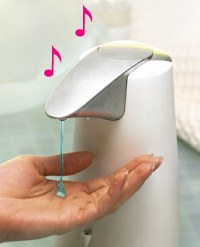Today’s public restroom is equipped with some surprisingly convenient gadgets. Chief among the new innovations has been the soap dispenser. Gone are the days of soap bars and pits in the ground.
As one might guess, there is an enormous variety in designs and functionality of soap dispensers. The most basic is the humble plunger mechanism. A quick pump or two will yield a handful of soap. While there isn’t much exciting about pump dispensers, a carefully chosen stainless steel soap dispenser beside a stylish sink and matching kitchen furniture can greatly enhance the appeal of any kitchen or restroom. Alternatively, a refillable bottle is an inexpensive, amiable, and simple addition to an existing counter-top.
An automatic soap dispenser can be had by those wanting a fancier option. These devices come in many different styles, features, and prices. However, the core operation remains simple. Soap is dispensed when motion is detected under the nozzle, with most units being battery-powered. Automatic soap dispensers can be loaded with not just soap, but also shampoo, lotion, hand sanitizer, and more. The better models come with a variety of features such as light and sound generators to aid the user in washing their hands thoroughly.
The most basic models are not very expensive, with straightforward design and functionality. A wall mounted soap dispenser is particularly convenient in a kitchen. The ability to avoid touching a soap pump with sticky, oily hands covered in food particles would greatly please cooks. Use in conjunction with a hands-free faucet for a truly impressive kitchen.
The biggest drawback to automated dispensers is their cost. Many of the personal consumer models have very basic sensor systems, so a counter-top accident is bound to happen with guests or unknowing users. They are also sometimes more wasteful and expensive than manual pumps. These are some of the points to be considered when choosing the right soap dispenser for your home.


















